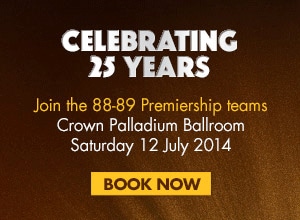In 2014, Hawthorn Football Club will commemorate the achievements of the 1988 and 1989 sides in winning back to back flags by wearing a commemorative guernsey against Geelong in Rounds 5 and 22. The Club will also host a function to celebrate the team's achievements in July.
If you think life is good as a Hawthorn supporter in 2014, coming off two premierships in five years, imagine how grand it was during the 1988 and 1989 seasons.
The Hawks lost just six games over those two seasons and won the premiership in both years.
In 1988, it came in imperious fashion, by 96 points over Melbourne in a Grand Final that for all intents and purposes, was over as a contest inside 15 minutes.
In 1989, it was far, far closer. Six points over Geelong in a Grand Final generally regarded as one of the best ever played. For Hawthorn it was particularly significant because the '89 flag marked the Club's first back-to-back triumph, after falling short several times before.
But the closeness of the result in 1989 should not hide the fact that the Hawks were clearly the best team all year. The Cats rode the hot hand into the Grand Final and played brilliantly for much of the day. Gary Ablett kicked nine goals in a spectacular performance, but aside from kicking the first goal of the afternoon, his team never held the lead. The Hawks kept the Cats at bay.
Hawthorn's brilliance in 1988 and 1989 was in various parts due to good planning and good fortune. The game was evolving rapidly from a Melbourne suburban competition into a national league. Measures designed to even up the competition - the national draft and the salary cap - had been introduced but had yet to take real effect.
So the Hawks made the most of their good fortune. The old zoning system, which pre-dates the draft, had been beneficial for Hawthorn as many of the Club’s best players such as Michael Tuck, Dermott Brereton, Gary Ayres, Chris Langford, Chris Mew and Robert DiPierdomenico, were products of Melbourne's inner-eastern suburbs and key tracts of the Mornington Peninsula and western Gippsland.
Hawthorn had also recruited shrewdly, and in some cases brilliantly, from interstate. Gary Buckenara (Western Australia), John Platten (South Australia), Darrin Pritchard (Tasmania) and Jason Dunstall (Queensland) were key members of both the 1988 and 1989 premierships. Tony Hall was impressive in 1988, but was denied a place in the team the following year when, in a cruel twist of fate, he damaged his knee in a tackle by Hawk teammate Andy Collins, when playing against each other in a Victoria-South Australia state of origin game at the MCG.
The Hawks had stars across every line. Brereton explained in an interview in 2011: "You can talk about things such as motivation but the simple fact was that we had the best players. There was once a state carnival (in 1988) and we had 17 State-of-Origin players in our side.”
"Put a side like that on the park today and if you looked at the market value of it, you'd have to pay twice the salary cap to keep them all."
Key defenders Chris Langford and Chris Mew were perennial state representatives, while back pocket Gary Ayres was a dual All-Australian. At the other end of the ground, Dunstall and Brereton were the best key forward combination in the league. Dunstall, who kicked more than 100 goals in both 1988 and 1989, would go on to become the third highest goalkicker in AFL history. Tuck, the tireless ruck-rover who was captain in 1988 and 1989, as well as of two other premiership sides, would play 426 games, the most of any player.
But the beauty of the side was that the Hawks had too many weapons to stop. Hall, Peter Curran and James Morrissey were lead-up third forwards and key components of Hawthorn’s well-oiled machine, but who would have been stars at any other club. Buckenara, by 1989 was the best half-forward flanker in the competition. The better teams of the time, Carlton, Essendon, Geelong and Melbourne, might have been able to clamp down on one or two of Hawthorn’s forwards but invariably the others would get off the hook.
Under the coaching of Allan Jeans, Hawthorn was a pioneer of the running game. For the Hawks, defence was often the first line of attack and the team played some irresistible football, running down the ground in waves and ramming the ball down the throat of the star-studded forward line. Jeans fell ill not long after the 1987 Grand Final defeat and was replaced for one season by Alan Joyce, the Club's then-Director of Football.
Like many Hawthorn people, Joyce bristled at the meek way in which the Hawks wilted in heat during the 1987 Grand Final loss to Carlton and his mantra the following year was to inject a bit more steel into the side. Back then it was called "sticking up for your mates". Today it would be called "unsociable football".
The beauty of Hawthorn Football Club in 1988 was it boasted a culture strong enough that Jeans could step away for a year and the side still produced one of the most dominating seasons in league history. The arrangement for Joyce to step in for the year was sealed with nothing more than a handshake.
Twelve months later, following another handshake, Joyce was back in his football director's office and Jeans was the coach again. And the team was driven like never before, to win for their coach and finally secure consecutive premierships. To ensure that this wasn't just a great era for Hawthorn, but one that was truly golden.
Previous chances for back-to-back flags in 1984 and 1987 went begging, despite the Hawks being the best team both seasons until Grand Final day. Any doubts over Hawthorn's desire to win in 1989 were dispelled in round six at Princes Park when, in one of the best home and away games ever played, the Hawks spotted Geelong a 56-point lead early in the third quarter before storming home to win by eight points.
It was the performance of a team at the height of its powers. The Hawks were beautifully balanced, with an age and experience profile perfect for a premiership team. They were tough, hard, brilliant to watch and were men on a mission.
Take nothing away from the wonderful team that Alastair Clarkson has put together in this highly socialistic modern era. His rags to riches transformation of the Club has been truly stunning.
But for Hawthorn fans of a certain age, going to the football every week to watch a team of champions go about their business, 1988 and 1989 will always be the best of times.
Hawthorn details from the 1988 and 1989 Grand Finals
1989
Hawthorn 21.18 (144) d Geelong 21.12 (138)
Coach: Allan Jeans
Captain: Michael Tuck
Backs: Andrew Collins, Chris Langford, Gary Ayres
Half-backs: Scott Maginness, Chris Mew, J Kennedy Jnr
Mid-field: Darrin Pritchard, Anthony Condon, Robert DiPierdomenico
Half-forwards: Dean Anderson, Dermott Brereton, Gary Buckenara
Forwards: Peter Curran, Jason Dunstall, Chris Wittman
Followers: Greg Dear, Michael Tuck, John Platten
Interchange: James Morrissey, Greg Madigan
Goal kickers: D Anderson 4, G Buckenara 4, J Dunstall 4, G Buckenara 4, D Brereton 3, P Curran 3, R DiPierdomenico 1, J Morrissey 1, C Wittman 1
Best players: D Pritchard, D Anderson, R DiPierdomenico, J Dunstall, G Buckenara, P Curran
1988
Hawthorn 22.20 (152) d Melbourne 6.20 (56)
Coach: Alan Joyce
Captain: Michael Tuck
Backs: Andrew Collins, Chris Langford, Gary Ayres
Half-backs: Scott Maginness, Chris Mew, Michael Tuck
Mid-field: Tony Hall, Peter Schwab, Robert DiPierdomenico
Half-forwards: Chris Wittman, Dermott Brereton, John Kennedy Jnr
Forwards: Paul Abbott, Jason Dunstall, James MorrisseyFollowers: Greg Dear, Gary Buckenara, John Platten
Interchange: Russell Greene, Darrin Pritchard
Goal kickers: J Dunstall 7, P Abbott 6, D Brereton 5, R DiPierdomenico 1, J Kennedy Jnr 1, J Morrissey 1, P Schwab 1
Best players: Gary Ayres, P Abbott, J Platten, P Schwab, J Dunstall, D Brereton
Norm Smith Medalist: Gary Ayres



